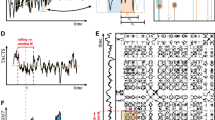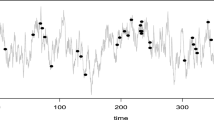Abstract
We show how the maximum of recurrence-microstates entropy configures a new way to properly compute appropriate recurrence vicinity parameter and time sampling to perform recurrence analysis of continuous data. For experimental data, we show the same procedure may be used to find the optimum sampling or to perform down-sampling of the data, preserving recurrence meaning and adjusting the ideal sampling. The new method retrieves results obtained using traditional methods with the advantage of being independent of any free parameter, since all parameter dependencies are automatically set. Our results are also less sensitive to noise when experimental data are used. Due to the automatized way to capture suitable recurrence parameters, the method is adequate for using in autonomous numerical algorithms, allowing the recovery of relevant recurrence information embedded in time series (including over-sampled data), rationalizing the process of data acquisition and allowing only relevant data to be collected.






Similar content being viewed by others
Data availability
The data that support the findings of this study are available from the corresponding author upon reasonable request. The SGAMP database containing single-unit neuronal recordings of North Atlantic squid (Loligo pealei) giant axons in response to stochastic stimulus currents is provided by PhysioNet [10, 23]. The data are open and free available at https://physionet.org/content/sgamp/1.0.0/.
References
Alligood, K.T., Sauer, T.D., Yorke, J.A.: Chaos: An Introduction to Dynamical Systems. Springer USA, New York (1996). https://doi.org/10.1007/0-387-22492-0_3
Chawla, N.V., Bowyer, K.W., Hall, L.O., Kegelmeyer, W.P.: Smote: synthetic minority over-sampling technique. J. Artif. Intell. Res. 16, 321–357 (2002)
Chua, L.O., Wu, C.W., Huang, A.: Guo-Qun Zhong: a universal circuit for studying and generating chaos—part I: routes to chaos. IEEE Trans. Circuits Syst. I Fundam. Theory Appl. 40(10), 732–744 (1993)
Corso, G., Prado, T.D.L., dos Santos Lima, G.Z., Kurths, J., Lopes, S.R.: Quantifying entropy using recurrence matrix microstates. Chaos Interdiscip. J. Nonlinear Sci. 28(8), 083108 (2018). https://doi.org/10.1063/1.5042026
Eckmann, J.P., Kamphorst, S.O., Ruelle, D.: Recurrence plots of dynamical systems. Europhys. Lett. 4(9), 973–977 (1987). https://doi.org/10.1209/0295-5075/4/9/004
Eroglu, D., Marwan, N., Prasad, S., Kurths, J.: Finding recurrence networks’ threshold adaptively for a specific time series. Nonlinear Process. Geophys. 21(6), 1085–1092 (2014)
Frank, R.J., Davey, N., Hunt, S.P.: Time series prediction and neural networks. J. Intell. Robot. Syst. 31(1), 91–103 (2001). https://doi.org/10.1023/A:1012074215150
Fraser, A.M., Swinney, H.L.: Independent coordinates for strange attractors from mutual information. Phys. Rev. A 33, 1134–1140 (1986). https://doi.org/10.1103/PhysRevA.33.1134
Froguel, L.B., de Lima Prado, T., Corso, G., dos Santos Lima, G.Z., Lopes, S.R.: Efficient computation of recurrence quantification analysis via microstates. Appl. Math. Comput. 428, 127175 (2022). https://doi.org/10.1016/j.amc.2022.127175
Goldberger, A.L., Amaral, L.A., Glass, L., Hausdorff, J.M., Ivanov, P.C., Mark, R.G., Mietus, J.E., Moody, G.B., Peng, C.K., Stanley, H.E.: Physiobank, physiotoolkit, and physionet: components of a new research resource for complex physiologic signals. Circulation [Online] 101(23), e215–e220 (2000)
Jaynes, E.T.: Information theory and statistical mechanics. Phys. Rev. 106, 620–630 (1957). https://doi.org/10.1103/PhysRev.106.620
Kantz, H., Schreiber, T.: Nonlinear time series analysis, 2 edn. Cambridge University Press (2004)
Kapur, J.N., Kesavan, H.K.: The generalized maximum entropy principle (with applications). Sandford Educational Press Canada (1987)
Kasdin, N.J.: Discrete simulation of colored noise and stochastic processes and 1/f/sup/spl alpha//power law noise generation. Proc. IEEE 83(5), 802–827 (1995)
Kraskov, A., Stögbauer, H., Grassberger, P.: Estimating mutual information. Phys. Rev. E 69, 066138 (2004). https://doi.org/10.1103/PhysRevE.69.066138
Kwapień, J., Drożdż, S., Liu, L., Ioannides, A.: Cooperative dynamics in auditory brain response. Phys. Rev. E 58, 6359–6367 (1998). https://doi.org/10.1103/PhysRevE.58.6359
Lopes, S., Prado, T., Corso, G., dos Santos Lima, G.Z., Kurths, J.: Parameter-free quantification of stochastic and chaotic signals. Chaos Solitons Fractals 133, 109616 (2020). https://doi.org/10.1016/j.chaos.2020.109616
Marwan, N.: How to avoid potential pitfalls in recurrence plot based data analysis. Int. J. Bifurc. Chaos 21(04), 1003–1017 (2011)
Marwan, N., Romano, M.C., Thiel, M., Kurths, J.: Recurrence plots for the analysis of complex systems. Phys. Rep. 438(5), 237–329 (2007)
Mewett, D.T., Reynolds, K.J., Nazeran, H.: Recurrence plot features: An example using ecg. In: ISSPA’99. Proceedings of the Fifth International Symposium on Signal Processing and its Applications (IEEE Cat. No. 99EX359), vol. 1, pp. 175–178. IEEE (1999)
Parlitz, U.: Lyapunov exponents from chua’s circuit. J. Circuits Syst. Comput. 3(02), 507–523 (1993)
Parlitz, U.: Estimating Lyapunov Exponents from Time Series, pp. 1–34. Springer Berlin Heidelberg, Berlin, Heidelberg (2016). https://doi.org/10.1007/978-3-662-48410-4_1
Paydarfar, D., Forger, D.B., Clay, J.R.: Noisy inputs and the induction of on-off switching behavior in a neuronal pacemaker. J. Neurophysiol. 96(6), 3338–3348 (2006). https://doi.org/10.1152/jn.00486.2006. (PMID: 16956993)
Prado, T.L., Boaretto, B.R.R., Corso, G., dos Santos Lima, G.Z., Kurths, J., Lopes, S.R.: A direct method to detect deterministic and stochastic properties of data. New J. Phys. 24(3), 033027 (2022). https://doi.org/10.1088/1367-2630/ac5057
Prado, T.L., Corso, G., dos Santos Lima, G.Z., Budzinski, R.C., Boaretto, B.R.R., Ferrari, F.A.S., Macau, E.E.N., Lopes, S.R.: Maximum entropy principle in recurrence plot analysis on stochastic and chaotic systems. Chaos Interdiscip. J. Nonlinear Sci. 30(4), 043123 (2020). https://doi.org/10.1063/1.5125921
Priestley, M.B.: Non-linear and non-stationary time series analysis. Academic Press (1988)
Pyle, D.: Data preparation for data mining. Morgan kaufmann (1999)
Renyi, A.: Probability Theory. North-Holland, Amsterdam (1970)
Rosenstein, M.T., Collins, J.J., De Luca, C.J.: A practical method for calculating largest lyapunov exponents from small data sets. Phys. D Nonlinear Phenom. 65(1), 117–134 (1993). https://doi.org/10.1016/0167-2789(93)90009-P
Schinkel, S., Dimigen, O., Marwan, N.: Selection of recurrence threshold for signal detection. Eur. Phys. J. Special Top. 164(1), 45–53 (2008)
Shannon, C.E.: A mathematical theory of communication. Bell Syst. Techn. J. 27(3), 379–423 (1948). https://doi.org/10.1002/j.1538-7305.1948.tb01338.x
Thiel, M., Romano, M.C., Kurths, J.: Analytical description of recurrence plots of white noise and chaotic processes (2003). https://doi.org/10.48550/ARXIV.NLIN/0301027
Thiel, M., Romano, M.C., Kurths, J., Meucci, R., Allaria, E., Arecchi, F.T.: Influence of observational noise on the recurrence quantification analysis. Phys. D Nonlinear Phenom. 171(3), 138–152 (2002)
von Toussaint, U.: Bayesian inference in physics. Rev. Mod. Phys. 83, 943–999 (2011). https://doi.org/10.1103/RevModPhys.83.943
Webber, C.L., Zbilut, J.P.: Dynamical assessment of physiological systems and states using recurrence plot strategies. J. Appl. Physiol. 76(2), 965–973 (1994)
Yang, D., Ren, W.X., Hu, Y.D., Li, D.: Selection of optimal threshold to construct recurrence plot for structural operational vibration measurements. J. Sound Vib. 349, 361–374 (2015)
Zayed, A.I.: Advances in Shannon’s sampling theory. Routledge (2018)
Zbilut, J.P., Webber, C.L.: Embeddings and delays as derived from quantification of recurrence plots. Phys. Lett. A 171(3–4), 199–203 (1992)
Zbilut, J.P., Zaldivar-Comenges, J.M., Strozzi, F.: Recurrence quantification based liapunov exponents for monitoring divergence in experimental data. Phys. Lett. A 297(3–4), 173–181 (2002)
Funding
We thank the Conselho Nacional de Desenvolvimento Científico e Tecnológico, CNPq—Brazil, grant numbers 308441/2021-4, 307907/2019-8, and 308621/2019-0 and Financiadora de Estudos e Projetos (FINEP) for financial support (LCPAD, CtInfra project).
Author information
Authors and Affiliations
Contributions
TLP was involved in the conceptualization; data curation; formal analysis; investigation; methodology; project administration; validation; and visualization. VSN contributed to the investigation and supporting. GC assisted in the investigation and supporting. GZSL contributed to the investigation and supporting. SRL contributed to the conceptualization; formal analysis; investigation; methodology; supervision; writing—original draft; writing—review & editing.
Corresponding author
Ethics declarations
Conflict of interest
The authors declare that they have no conflict of interest.
Additional information
Publisher's Note
Springer Nature remains neutral with regard to jurisdictional claims in published maps and institutional affiliations.
Rights and permissions
Springer Nature or its licensor (e.g. a society or other partner) holds exclusive rights to this article under a publishing agreement with the author(s) or other rightsholder(s); author self-archiving of the accepted manuscript version of this article is solely governed by the terms of such publishing agreement and applicable law.
About this article
Cite this article
de Lima Prado, T., Machado, V.S., Corso, G. et al. How to compute suitable vicinity parameter and sampling time of recurrence analysis. Nonlinear Dyn 112, 1141–1152 (2024). https://doi.org/10.1007/s11071-023-09063-9
Received:
Accepted:
Published:
Issue Date:
DOI: https://doi.org/10.1007/s11071-023-09063-9
Keywords
Profiles
- Thiago de Lima Prado View author profile




